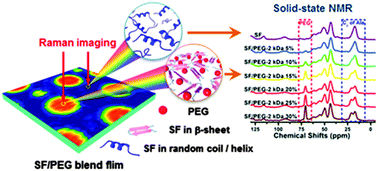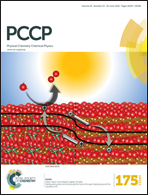In situ microscopic studies on the structures and phase behaviors of SF/PEG films using solid-state NMR and Raman imaging†
Abstract
In order to overcome the drawbacks of silk fibroin (SF)-based materials, SF has been blended with some polymers. Before using the blend material, understanding of the structures and phase behaviors of the blend is thought to be essential. In this study, solid-state 13C CP-MAS NMR and Raman imaging techniques were used to study the structures and phase behaviors of blends of SF with polyethylene glycol (PEG) at a molecular weight that varied from 2 to 20 kDa and a blend ratio of SF/PEG from 95/5 to 70/30 (w/w%) at the molecular and microscopic levels. It is found that the conformational transition of SF to the β-sheet increased as the PEG content increased, while the amount of the formed β-sheet conformers was decreased as the PEG molecular weight increased for a given content. It is also observed that SF was incompatible with PEG to some extent. The phase separation into “sea” and “island” domains took place in the SF/PEG blend films. SF was dominantly present in the “sea” domain, while PEG in the “island” domains. The conformation of SF in the interface between SF and PEG was changed to the β-sheet, while that in the protein-rich domain remained in the random coil and/or helix conformation. These observations suggest that the specifically expected materials, for example, the silk-based microspheres or scaffold materials can be manufactured by controlling the molecular weight and content of PEG in the blend system.


 Please wait while we load your content...
Please wait while we load your content...